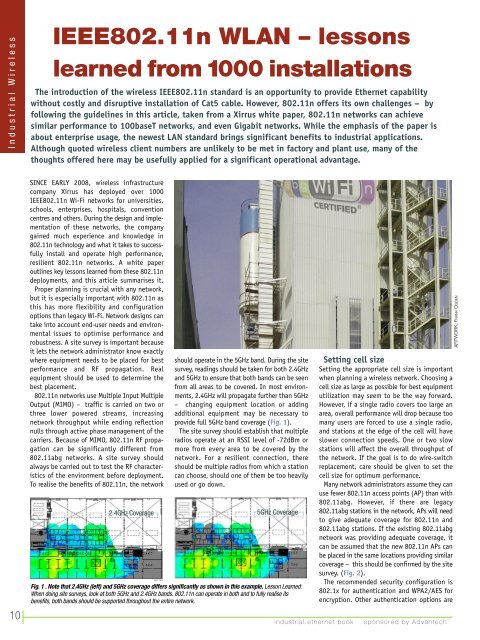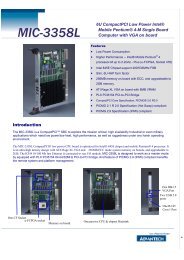industrial wireless book special edition - Networking ...
industrial wireless book special edition - Networking ...
industrial wireless book special edition - Networking ...
Create successful ePaper yourself
Turn your PDF publications into a flip-book with our unique Google optimized e-Paper software.
I n d u s t r i a l W i r e l e s s<br />
IEEE802.11n WLAN – lessons<br />
learned from 1000 installations<br />
The introduction of the <strong>wireless</strong> IEEE802.11n standard is an opportunity to provide Ethernet capability<br />
without costly and disruptive installation of Cat5 cable. However, 802.11n offers its own challenges – by<br />
following the guidelines in this article, taken from a Xirrus white paper, 802.11n networks can achieve<br />
similar performance to 100baseT networks, and even Gigabit networks. While the emphasis of the paper is<br />
about enterprise usage, the newest LAN standard brings significant benefits to <strong>industrial</strong> applications.<br />
Although quoted <strong>wireless</strong> client numbers are unlikely to be met in factory and plant use, many of the<br />
thoughts offered here may be usefully applied for a significant operational advantage.<br />
10<br />
SINCE EARLY 2008, <strong>wireless</strong> infrastructure<br />
company Xirrus has deployed over 1000<br />
IEEE802.11n Wi-Fi networks for universities,<br />
schools, enterprises, hospitals, convention<br />
centres and others. During the design and implementation<br />
of these networks, the company<br />
gained much experience and knowledge in<br />
802.11n technology and what it takes to successfully<br />
install and operate high performance,<br />
resilient 802.11n networks. A white paper<br />
outlines key lessons learned from these 802.11n<br />
deployments, and this article summarises it.<br />
Proper planning is crucial with any network,<br />
but it is e<strong>special</strong>ly important with 802.11n as<br />
this has more flexibility and configuration<br />
options than legacy Wi-Fi. Network designs can<br />
take into account end-user needs and environmental<br />
issues to optimise performance and<br />
robustness. A site survey is important because<br />
it lets the network administrator know exactly<br />
where equipment needs to be placed for best<br />
performance and RF propagation. Real<br />
equipment should be used to determine the<br />
best placement.<br />
802.11n networks use Multiple Input Multiple<br />
Output (MIMO) – traffic is carried on two or<br />
three lower powered streams, increasing<br />
network throughput while ending reflection<br />
nulls through active phase management of the<br />
carriers. Because of MIMO, 802.11n RF propagation<br />
can be significantly different from<br />
802.11abg networks. A site survey should<br />
always be carried out to test the RF characteristics<br />
of the environment before deployment.<br />
To realise the benefits of 802.11n, the network<br />
2.4GHz Coverage<br />
should operate in the 5GHz band. During the site<br />
survey, readings should be taken for both 2.4GHz<br />
and 5GHz to ensure that both bands can be seen<br />
from all areas to be covered. In most environments,<br />
2.4GHz will propagate further than 5GHz<br />
– changing equipment location or adding<br />
additional equipment may be necessary to<br />
provide full 5GHz band coverage (Fig. 1).<br />
The site survey should establish that multiple<br />
radios operate at an RSSI level of -72dBm or<br />
more from every area to be covered by the<br />
network. For a resilient connection, there<br />
should be multiple radios from which a station<br />
can choose, should one of them be too heavily<br />
used or go down.<br />
5GHz Coverage<br />
Fig. 1 . Note that 2.4GHz (left) and 5GHz coverage differs significantly as shown in this example. Lesson Learned:<br />
When doing site surveys, look at both 5GHz and 2.4GHz bands. 802.11n can operate in both and to fully realise its<br />
benefits, both bands should be supported throughout the entire network.<br />
<strong>industrial</strong> ethernet <strong>book</strong><br />
10<br />
Setting cell size<br />
Setting the appropriate cell size is important<br />
when planning a <strong>wireless</strong> network. Choosing a<br />
cell size as large as possible for best equipment<br />
utilization may seem to be the way forward.<br />
However, if a single radio covers too large an<br />
area, overall performance will drop because too<br />
many users are forced to use a single radio,<br />
and stations at the edge of the cell will have<br />
slower connection speeds. One or two slow<br />
stations will affect the overall throughput of<br />
the network. If the goal is to do wire-switch<br />
replacement, care should be given to set the<br />
cell size for optimum performance.<br />
Many network administrators assume they can<br />
use fewer 802.11n access points (AP) than with<br />
802.11abg. However, if there are legacy<br />
802.11abg stations in the network, APs will need<br />
to give adequate coverage for 802.11n and<br />
802.11abg stations. If the existing 802.11abg<br />
network was providing adequate coverage, it<br />
can be assumed that the new 802.11n APs can<br />
be placed in the same locations providing similar<br />
coverage – this should be confirmed by the site<br />
survey. (Fig. 2).<br />
The recommended security configuration is<br />
802.1x for authentication and WPA2/AES for<br />
encryption. Other authentication options are<br />
sponsored by Advantech<br />
ARTWORK: FRANK OGDEN

















